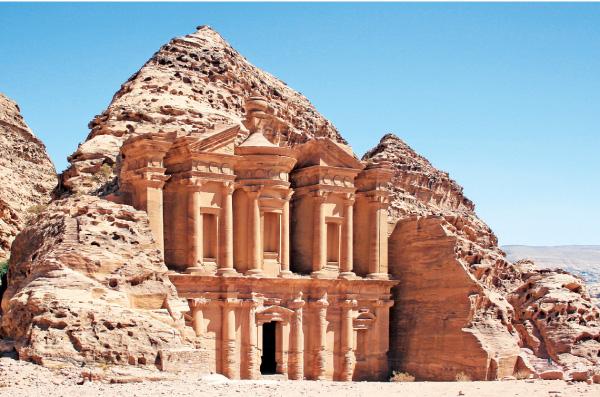
Some structures in the world are outstandingly magnificent. They leave visitors wonderstruck and are therefore, known as “Wonders of the World.” These structures remind us of our past, as well as the natural world around us.
In ancient times, these magnificent structures were built using simple techniques and machines. These structures were the result of human intelligence, artistic skills and a huge labour force.
Petra
Petra is an ancient city built with rocks. In Greek, the word Petra means ‘rock.’ The city is famous for its beautiful buildings, which were carved from red sandstone hills. Petra was built between 100 BC and 10 AD and is located in southwestern Jordan.
A Trade City
Petra was the capital city of an Arab tribe called Nabataeans. Nabataeans were Nomads who lived around 2,000 years ago. Petra became an important trading centre when they started trading. Traders from China, India, Southern Arabia, Egypt, Syria, Greece and Rome crossed Petra. They traded in textiles, incense, silk and spices.
Carving a Tomb
The city of Petra has hundreds of tombs and buildings. They were carved by skilled stonemasons, who carved the stone from top to bottom. The stonemasons were guided by the master artisan.
Theme and design
Nabataeans were very much inspired by the designs of East and West. They carved vines, flowers, animals and people. A 42-metres (138 feet) high temple in front of the El-Deir Monastery is the best example of the Natabaea designs.
Facts:
* Nabataeans built a theatre like what the Greeks and Romans built, with sitting space for 4,000 people.
* Petra’s water supply system supplied 12 million gallons of water every day, enough for 100,000 Americans.
*Petra was first discovered by a Swiss traveller, Johann L. Burckhardt.
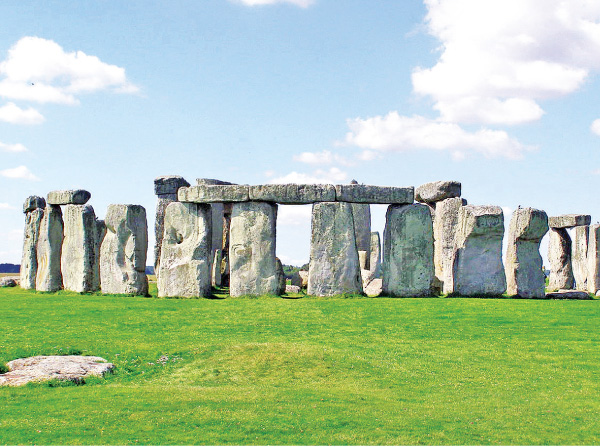
Stonehenge
Stonehenge near Salisbury in Wiltshire in Southern England is one of the oldest and most wonderful ancient structures. It was built around 5,000 years ago. The builders of this awe-inspiring structure and the purpose of its construction are still cloaked in mystery.
Inner Stone Circle
Construction work on the Stonehenge began as a round earthen bank and ditch with wooden posts. Later in 2600 BC, the wooden posts were swapped by 80 bluestones. Each bluestone weighed up to four tons. These stones were believed to have been brought from Preseli Mountains situated 386 milometres (240 miles) away in Wales. They formed the Inner Stone Circle of Stonehenge.
Outer Stone Circle
A few years later, ‘Sarsen’ stones were brought from Marlborough Towns 30 kilometres (20 miles) north of Stonehenge. These giant sandstone slabs were about 2.4 metres (8 feet) wide, 1.5 metres (5 feet) thick and 7.6 metres (25 feet) long. Each of the slabs weighed about 20 to 30 tons. About 30 sarsen stones were used to build the outer circle.
Trilithons
A trilithon is a structure of two stones vertically placed on ground which were supported by a third stone placed horizontally over them. Five trilithons each weighing 50 tons were arranged from smaller to bigger, in a shape of horseshoe in the Stonehenge.
Facts:
*In Greek, Trilithon means ‘three sontes’. * Many researchers believe that the Stonehenge was an astronomical site which some believe was a place of worship.
* According to a research, it probably took about 20 million hours to construct Stonehenge.
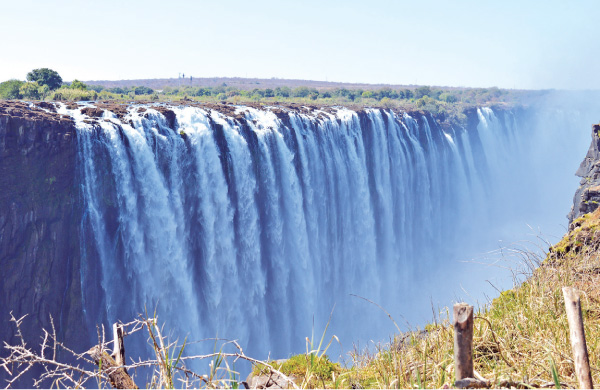
Victoria Falls
Victoria Falls is one of the greatest and most beautiful waterfalls in the world. It lies on the Zambezi River that flows from the border of two south central African countries, Zambia and Zimbabwe.
Widest in the World
Victoria Falls is around 1.6 milometres (1 mile) wide and more than 108 metres (354 feet) deep. It is twice as wide and deep as Niagara Falls.
Discovery of the Falls
Victoria Falls was discovered by the British explorer David Livingstone in 1855. Livingstone named the falls after British monarch Queen Victoria.
Flying Water
Victoria Falls has the largest falling water sheet in the world. Every minute, Victoria Falls tumbles 142 billion gallons of water deep into the valley. The falling water thunders and its drizzle flies up to a height of 304 metres (997 feet). When sunlight falls on the drizzles, it forms beautiful rainbows.
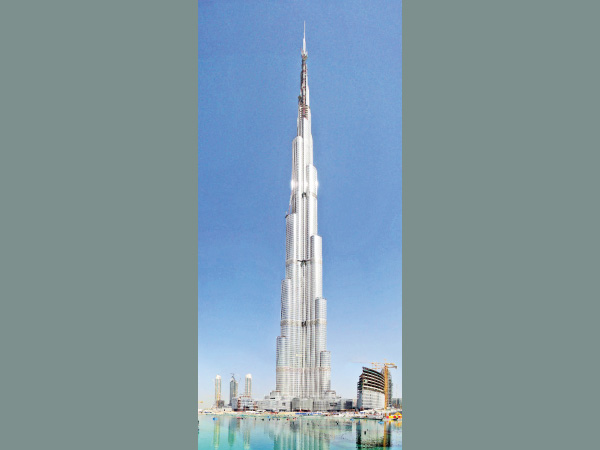
Burj Khalifa
Burj Khalifa is the tallest skyscraper in the world. This tallest man-made free standing structure is in Dubai, United Arab Emirates. Initially the soaring building was called as Burj Dubai but was renamed after the President of the UAE and Sheikh, Khalifa bin Zayed Al Nahayan.
Construction
The construction of Burj Khalifa began in September 21, 2004. More than 45,000 cubic metres (58,900 cubic yards) of concrete were used for the construction of the foundation of Burj Khalifa.
Great Statue
Burj Khalifa is 828 metres (2,716 feet) tall and has around 200 floors out of which 163 are for living purposes. The building has 1044 luxury apartments, office floors and Armani hotel and residences. Burj Khalifa is so tall its spire can be seen 95 kilometres (60 miles) away.
World’s grandest
Burj Khalifa has the world’s highest observation deck on its 124th floor, highest mosque on 158th floor, tallest life service and highest occupied floor. The skyscraper is even much taller than Taipei 101, the previous record holder of the tallest building. Taipei 101 was 509 metres (1,671 feet) tall.
Facts:
* The world’s tallest performing fountain, the Dubai Fountain lies at the bottom of the Burj Khalifa.
* The total weight of aluminium used in the construction of Burj Khalifa is equal to that of five A 380 aircraft.
* Burj Khalifa became operational for public from January 4, 2010.
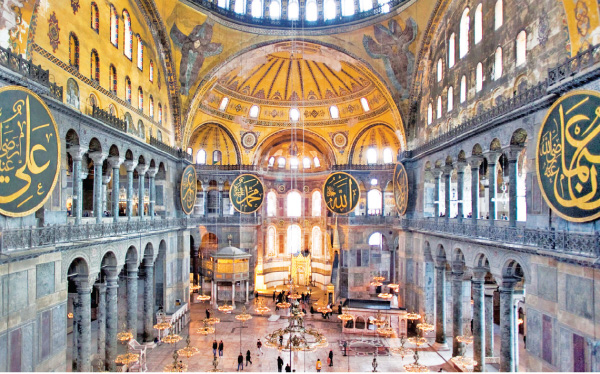
Hagia Sophia
The Hagia Sophia, is a former church and mosque, and now a museum of Byzantine Art. It is in Istanbul, Turkey. The Hagia Sophia was built as a church by the Byzantine Emperor Justinian I in 537 AD. The church was converted into a mosque in 1453 when Constantinople was conquered by the Ottoman Turks. In 1935, it was turned into the Ayasofya Museum by the Turkish President, Kemal Ataturk.
The Dome
The Hagia Sophia is one of the finest works of Byzantine architecture. It is famous all over the world for its huge dome. It is 31 metres (102 feet) in diameter and 56 metres (184 feet) high with 40 windows. The windows illuminate the hall.
The decorations
The interior of the Hagia Sophia was beautifully decorated. Mosaic paintings were the most popular of various methods used in the cathedral. They were made by using stone, glass and other materials over a gold background. The most famous of all paintings was of Jesus Christ sitting between Emperor Constantine and Justinian.
Facts:
* Around 10,000 workers worked on construction of the Hagia Sophia.
* Around 600 people were appointed by the Emperor to serve the great church.
* Hagia Sophia is a Greet word, which means “Holy Wisdom of Christ.”
*Hagia Sophia was built in less than six years.
